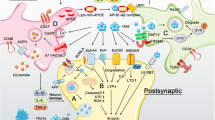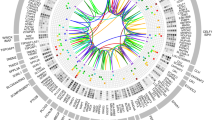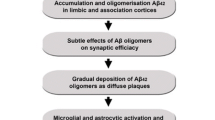Abstract
Alzheimer’s Disease (AD) is a progressive, irreversible neurodegenerative disease. Despite several genetic mutations (Haass et al., J. Biol. Chem. 269:17741–17748, 1994; Ancolio et al., Proc. Natl. Acad. Sci. USA 96:4119–4124, 1999; Munoz and Feldman, CMAJ 162:65–72, 2000; Gatz et al., Neurobiol. Aging 26:439–447, 2005) found in AD patients, more than 90% of AD cases are sporadic (Bertram and Tanzi, Hum. Mol. Genet. 13:R135–R141, 2004). Therefore, it is plausible that environmental exposure may be an etiologic factor in the pathogenesis of AD. The AD brain is characterized by extracellular beta-amyloid (Aβ) deposition and intracellular hyperphosphorylated tau protein. Our lab has demonstrated that developmental exposure of rodents to the heavy metal lead (Pb) increases APP (amyloid precursor protein) and Aβ production later in the aging brain (Basha et al., J. Neurosci. 25:823–829, 2005a). We also found elevations in the oxidative marker 8-oxo-dG in older animals that had been developmentally exposed to Pb (Bolin et al., FASEB J. 20:788–790, 2006) as well as promotion of amyloidogenic histopathology in primates. These findings indicate that early life experiences contribute to amyloidogenesis in old age perhaps through epigenetic pathways. Here we explore the role of epigenetics as the underlying mechanism that mediates this early exposure-latent pathogenesis with a special emphasis on alterations in the methylation profiles of CpG dinucleotides in the promoters of genes and their influence on both gene transcription and oxidative DNA damage.
Similar content being viewed by others
References
Abbott, R. D., White, L. R., Ross, G. W., Petrovitch, H., Masaki, K. H., Snowdon, D. A., et al. (1998). Height as a marker of childhood development and late-life cognitive function: The Honolulu–Asia Aging Study. Pediatrics, 102, 602–609.
Ancolio, K., Dumanchin, C., Barelli, H., Warter, J. M., Brice, A., Campion, D., et al. (1999). Unusual phenotypic alteration of beta amyloid precursor protein (betaAPP) maturation by a new Val-715 –> Met betaAPP-770 mutation responsible for probable early-onset Alzheimer’s disease. Proceedings of the National Academy of Sciences of the United States of America, 96, 4119–4124.
Barker, D. J., Winter, P. D., Osmond, C., Margetts, B., & Simmonds, S. J. (1989). Weight in infancy and death from ischaemic heart disease. Lancet, 8663, 577–580.
Basha, M. R., Wei, W., Bakheet, S. A., Benitez, N., Siddiqi, H. K., Ge, Y., et al. (2005a) The fetal-basis of amyloidogenesis: Exposure to lead and latent over-expression of amyloid precursor protein and β-amyloid in the aging brain. Journal of Neuroscience, 25, 823–829.
Basha, M. R., Wu, J., Wei, W., Siddiqi, H., Brock, B., Anderson, A., et al. (2005b). Lead (Pb) and the developmental origin of Alzheimer’s disease. Pediatric Research, 58(5), 1026.
Bertram, L., & Tanzi, R. E. (2004). Alzheimer’s disease: One disorder, too many genes? Human Molecular Genetics, 13, R135–R141.
Bolin, C. M., Basha, R., Cox, D., Zawia, N. H., Maloney, B., Lahiri, D. K., et al. (2006). Exposure to lead and the developmental origin of oxidative DNA damage in the aging brain. FASEB Journal, 20, 788–790.
Butterfield, D. A. (2002). Amyloid β-peptide (1–42)-induced oxidative stress and neurotoxicity: Implications for neurodegeneration in Alzheimer’s disease brain. A review. Free Radical Research, 36, 1307–1313.
Castellani, R. J., Lee, H. G., Perry, G., & Smith, M. A. (2006). Antioxidant protection and neurodegenerative disease: The role of amyloid-beta and tau. American Journal of Alzheimer’s Disease and Other Dementias, 21, 126–130.
Clark, S. J., Harrison, J., & Molloy, P. L. (1997). Sp1 binding is inhibited by (m)Cp(m)CpG methylation. Gene, 195, 67–71.
Clarke, R., Smith, A. D., Jobst, K. A., Refsum, H., Sutton, L., & Ueland, P. M. (1998). Folate, vitamin B12, and serum total homocysteine levels in confirmed Alzheimer disease. Archives of Neurology, 55, 1449–1455.
Conel, J. L. (1939). The brain structure of the new born infant and consideration of the senile brain: In the inter-relationship of mind and body (pp. 247–255). Cambridge, MA: Harvard University Press.
Cory-Slechta, D. A., Gilbert, M. E., Tiffany-Castiglioni, E., Zawia, N. H., Virgolini, M., Rossi-George, A., et al. (2007). New concepts in the neurotoxicology of lead (Pb). Toxicology and Applied Pharmacology (in press).
Cummings, J. L. (2004). Alzheimer’s disease. Neuroscience Letters, 351, 56–67.
Eckman, C. B., Mehta, N. D., Crook, R., Perez-tur, J., Prihar, G., Pfeiffer, E., et al. (1997). A new pathogenic mutation in the APP gene (I716V) increases the relative proportion of A beta 42(43). Human Molecular Genetics, 6, 2087–2089.
Emanuel, I. (1997). Invited commentary: An assessment of maternal intergenerational factors in pregnancy outcome. American Journal of Epidemiology, 146, 820–825.
Feil, R. (2006). Environmental and nutritional effects on the epigenetic regulation of genes. Mutation Research, 600, 46–57.
Feng, X., Zhao, P., He, Y., & Zuo, Z. (2006). Allele-specific silencing of Alzheimer’s disease genes: The amyloid precursor protein genes with Swedish or London mutations. Gene, 371, 68–74.
Fuso, A., Seminara, L., Cavallaro, R. A., D'Anselmi, F., & Scarpa, S. (2005). S-adenosylmethionine/homocysteine cycle alterations modify DNA methylation status with consequent deregulation of PS1 and BACE and beta-amyloid production. Molecular and Cellular Neurosciences, 28, 194–204.
Gatz, M., Fratiglioni, L., Johansson, B., Berg, S., Mortimer, J. A., Reynolds, C. A., et al. (2005). Complete ascertainment of dementia in the Swedish Twin Registry: The HARMONY study. Neurobiology of Aging, 26, 439–447.
Gatz, M., Pedersen, N. L., Berg, S., Johansson, B., Johansson, K., and Mortimer, J. A., et al. (1997). Heritability for Alzheimer’s disease: The study of dementia in Swedish twins. Journals of Gerontology. Series A, Biological Sciences and Medical Sciences, 52, M117–M125.
Goedart, M., & Spillantini, M. G. (2006). A century of Alzheimer’s disease. Science, 314, 777–781.
Gorell, J. M., Rybicki, B. A., Cole Johnson, C., & Peterson, E. L. (1999). Occupational metal exposures and the risk of Parkinson’s disease. Neuroepidemiology, 18, 303–308.
Graves, A. B., Mortimer, J. A., Larson, E. B., Wenzlow, A., Bowen, J. D., & McCormick, W. C. (1996). Head circumference as a measure of cognitive reserve. Association with severity of impairment in Alzheimer’s disease. British Journal of Psychiatry, 169, 86–92.
Haass, C., Hung, A. Y., Selkoe, D. J., & Teplow, D. B. (1994). Mutations associated with a locus for familial Alzheimer’s disease result in alternative processing of amyloid beta-protein precursor. Journal of Biological Chemistry, 269, 17741–17748.
Haraguchi, T., Ishizu, H., Takehisa, Y., Kawai, K., Yokota, O., Terada, S., et al. (2001). Lead content of brain tissue in diffuse neurofibrillary tangles with calcification (DNTC): The possibility of lead neurotoxicity. NeuroReport, 21, 3887–3890.
Hardy, J. A., & Higgins, G. A. (1992). Alzheimer’s disease: The amyloid cascade hypothesis. Science, 256, 184–185.
Hebert, L. E., Scherr, P. A., Bienias, J. L., Bennett, D. A., & Evans, D. A. (2003). Alzheimer disease in the US population: Prevalence estimates using the 2000 census. Archives of Neurology, 60, 1119–1122.
Hoffman, P. W., & Chernak, J. M. (1995). DNA binding and regulatory effects of transcription factors SP1 and USF at the rat amyloid precursor protein gene promoter. Nucleic Acids Research, 25, 2229–2235.
Hoyer, A., Bardenheuer, H. J., Martin, E., & Plaschke, K. (2005). Amyloid precursor protein (APP) and its derivatives change after cellular energy depletion. An in vitro-study. Journal of Neural Transmission, 112, 239–253.
Jacobson, J. L., & Jacobson, S. W. (1991). Assessment of teratogenic effects on cognitive and behavioral development in infancy and childhood. NIDA Research Monograph, 114, 248–261.
Kamel, F., Umbach, D. M., Munsat, T. L., Shefner, J. M., Hu, H., & Sandler, D. P. (2002). Lead exposure and amyotrophic lateral sclerosis. Epidemiology, 13, 311–319.
Kramer, M. S., & Joseph, K. S. (1996). Enigma of fetal/infant-origins hypothesis. Lancet, 348, 1254–1255.
Liu, G., Huang, W., Moir, R. D., Vanderburg, C. R., Lai, B., Peng, Z., et al. (2006). Metal exposure and Alzheimer’s pathogenesis. Journal of Structural Biology, 155, 45–51.
Lukiw, W. J., Rogaev, E. I., Wong, L., Vaula, G., McLachlan, D. R., & St George Hyslop, P. (1994). Protein-DNA interactions in the promoter region of the amyloid precursor protein (APP) gene in human neocortex. Brain Research. Molecular Brain Research, 22, 121–131.
Mattson, M. P. (1997). Cellular actions of beta-amyloid precursor protein and its soluble and fibrillogenic derivatives. Physiological Reviews, 77, 1081–1132.
Mulder, C., Schoonenboom, N. S., Jansen, E. E., Verhoeven, N. M., van Kamp, G. J., Jakobs, C., et al. (2005). The transmethylation cycle in the brain of Alzheimer patients. Neuroscience Letters, 386, 69–71.
Munoz, D. G., & Feldman, H. (2000). Causes of Alzheimer’s disease. Canadian Medical Association Journal, 162, 65–72.
Nagane, Y., Utsugisawa, K., & Tohgi, H. (2000). PCR amplification in bisulfite methylcytosine mapping in the GC-rich promoter region of amyloid precursor protein gene in autopsy human brain. Brain Research. Brain Research Protocols, 5, 167–171.
Niculescu, M. D., Craciunescu, C. N., & Zeisel, S. H. (2005). Gene expression profiling of choline-deprived neural precursor cells isolated from mouse brain. Molecular Brain Research, 134, 309–322.
Niculescu, M. D., Craciunescu, C. N., & Zeisel, S. H. (2006). Dietary choline deficiency alters global and gene-specific DNA methylation in the developing hippocampus of mouse fetal brains. The FASEB Journal, 20, 43–49.
Niklowitz, W. J., & Mandybur, T. I. (1975). Neurofibrillary changes following childhood lead encephalopathy. Journal of Neuropathology and Experimental Neurology, 34, 445–455.
Obeid, R., Herrmann, W. (2006). Mechanism of homocysteine neurotoxicity in neurodegenerative diseases with special reference to dementia. FEBS Letters, 580, 2994–3005.
Obregon, D. F., Rezai-Zadeh, K., Bai, Y., Sun, N., Hou, H., Ehrhart, J., et al. (2006). ADAM10 activation is required for green tea (−)-epigallocatechin-3-gallate-induced alpha-secretase cleavage of amyloid precursor protein. Journal of Biological Chemistry, 281, 16419–16427.
Ono, K., Hamaguchi, T., Naiki, H., & Yamada, M. (2006). Anti-amyloidogenic effects of antioxidants: Implications for the prevention and therapeutics of Alzheimer’s disease. Biochimica et Biophysica Acta, 1762, 575–586.
Pollwein, P., Masters, C. L., & Beyreuther, K. (1992). The expression of the amyloid precursor protein (APP) is regulated by two GC-elements in the promoter. Nucleic Acids Research, 20, 63–68.
Querfurth, H. W., Jiang, J., Xia, W., & Selkoe, D. J. (1999). Enhancer function and novel DNA binding protein activity in the near upstream betaAPP gene promoter. Gene, 232, 125–141.
Raiha, I., Kaprio, J., Koskenvuo, M., Rajala, T., & Sourander, L. (1997). Alzheimer’s disease in twins. Biomedicine & Pharmacotherapy, 51, 101–104.
Rogaev, E. I., Lukiw, W. J., Lavrushina, O., Rogaeva, E. A., & St George-Hyslop, P. H. (1994). The upstream promoter of the beta-amyloid precursor protein gene (APP) shows differential patterns of methylation in human brain. Genomics, 22, 340–347.
Salbaum, J. M., Weidemann, A., Masters, C. L., & Beyreuther, K. (1989). The promoter of Alzheimer’s disease amyloid A4 precursor gene. Progress in Clinical and Biological Research, 317, 277–283.
Scarpa, S., Cavallaro, A. R., D'Anselmi, F., & Fuso, A. (2006). Gene silencing through methylation: An epigenetic intervention on Alzheimer disease. Journal of Alzheimer’s Disease, 9, 407–414.
Scarpa, S., Fuso, A., D'Anselmi, F., & Cavallaro, R. A. (2003). Presenilin 1 gene silencing by S-adenosylmethionine: A treatment for Alzheimer disease. FEBS Letters, 541, 145–148.
Selkoe, D. J. (2001). Alzheimer’s disease: Genes, proteins, and therapy. Physiological Reviews, 81, 741–766.
Snowdon, D. A., Kemper, S. J., Mortimer, J. A., Greiner, L. H., Wekstein, D. R., & Markesbery, W. R. (1996). Linguistic ability in early life and cognitive function and Alzheimer’s disease in late life. Findings from the Nun Study. JAMA, 275, 528–532.
Spillantini, M. G., Goedert, M., Crowther, R. A., Murrell, J. R., Farlow, M. R., & Ghetti, B. (1997). Familial multiple system tauopathy with presenile dementia: A disease with abundant neuronal and glial tau filaments. Proceedings of the National Academy of Sciences of the United States of America, 94, 4113–4118.
Stewart, W. F., Schwartz, B. S., Davatzikos, C., Shen, D., Liu, D., Wu, X., et al. (2006). Past adult lead exposure is linked to neurodegeneration measured by brain MRI. Neurology, 66, 1476–1484.
Stewart, W. F., Schwartz, B. S., Simon, D., Kelsey, K., & Todd, A. C. (2002). ApoE genotype, past adult lead exposure, and neurobehavioral function. Environmental Health Perspectives, 110, 501–505.
Suh, Y. H., & Checler, F. (2002). Amyloid precursor protein, presenilins, and alpha-synuclein: Molecular pathogenesis and pharmacological applications in Alzheimer’s disease. Pharmacological Reviews, 54, 469–525.
Tanner, T. (1978). Circling behaviour in the rat following unilateral injections of p-chlorophenylalanine and ethanolamine-O-sulphate into the substantia nigra. Journal of Pharmacy and Pharmacology, 30, 158–161.
Tohgi, H., Utsugisawa, K., Nagane, Y., Yoshimura, M., Genda, Y., & Ukitsu, M. (1999). Reduction with age in methylcytosine in the promoter region −224 approximately −101 of the amyloid precursor protein gene in autopsy human cortex. Brain Research. Molecular Brain Research, 70, 288–292.
Turk, W. P., Layoun, A., Smith, S. S., & Weitzman, S. A. (1995). DNA adduct 8-hydroxyl-2′-deoxyguanosine (8-hydeoxyguanine) affects function of human DNA methyltansferase. Carcinogenesis, 16, 1253–1255.
Tyagi, N., Moshal, K. S., Ovechkin, A. V., Rodriguez, W., Steed, M., Henderson, B., et al. (2005). Mitochondrial mechanism of oxidative stress and systemic hypertension in hyperhomocysteinemia. Journal of Cellular Biochemistry, 96, 665–671.
Valinluck, V., Tsai, H. H., Rogstad, D. K., Burdzy, A., Bird, A., & Sowers, L. C. (2004). Oxidative damage to methyl-CpG sequences inhibits the binding of the methyl-CpG binding domain (MBD) of methyl-CpG binding protein 2(MeCP2). Nucleic Acids Research, 32, 4100–4108.
Weitzman, A. S., Turk, W. P., Milkowski, D. H., & Kozlowski, K. (1994). Free radical adducts induce alterations in DNA cytosine methylation. Proceedings of the National Academy of Sciences of the United States of America, 91, 1261–1264.
Yatin, S. M., Varadarajan, S., & Butterfield, D. A. (2000). Vitamin E prevents Alzheimer’s amyloid beta-peptide (1–42)-induced neuronal protein oxidation and reactive oxygen species production. Journal of Alzheimer’s Disease, 2, 123–131.
Zhu, W. G., Srinivasan, K., Dai, Z., Duan, W., Druhan, L. J., Ding, H., et al. (2003). Methylation of adjacent CpG sites affects Sp1/Sp3 binding and activity in the p21(Cip1) promoter. Molecular and Cellular Biology, 23, 4056–4065.
Author information
Authors and Affiliations
Corresponding author
Rights and permissions
About this article
Cite this article
Wu, J., Basha, M.R. & Zawia, N.H. The Environment, Epigenetics and Amyloidogenesis. J Mol Neurosci 34, 1–7 (2008). https://doi.org/10.1007/s12031-007-0009-4
Accepted:
Published:
Issue Date:
DOI: https://doi.org/10.1007/s12031-007-0009-4




